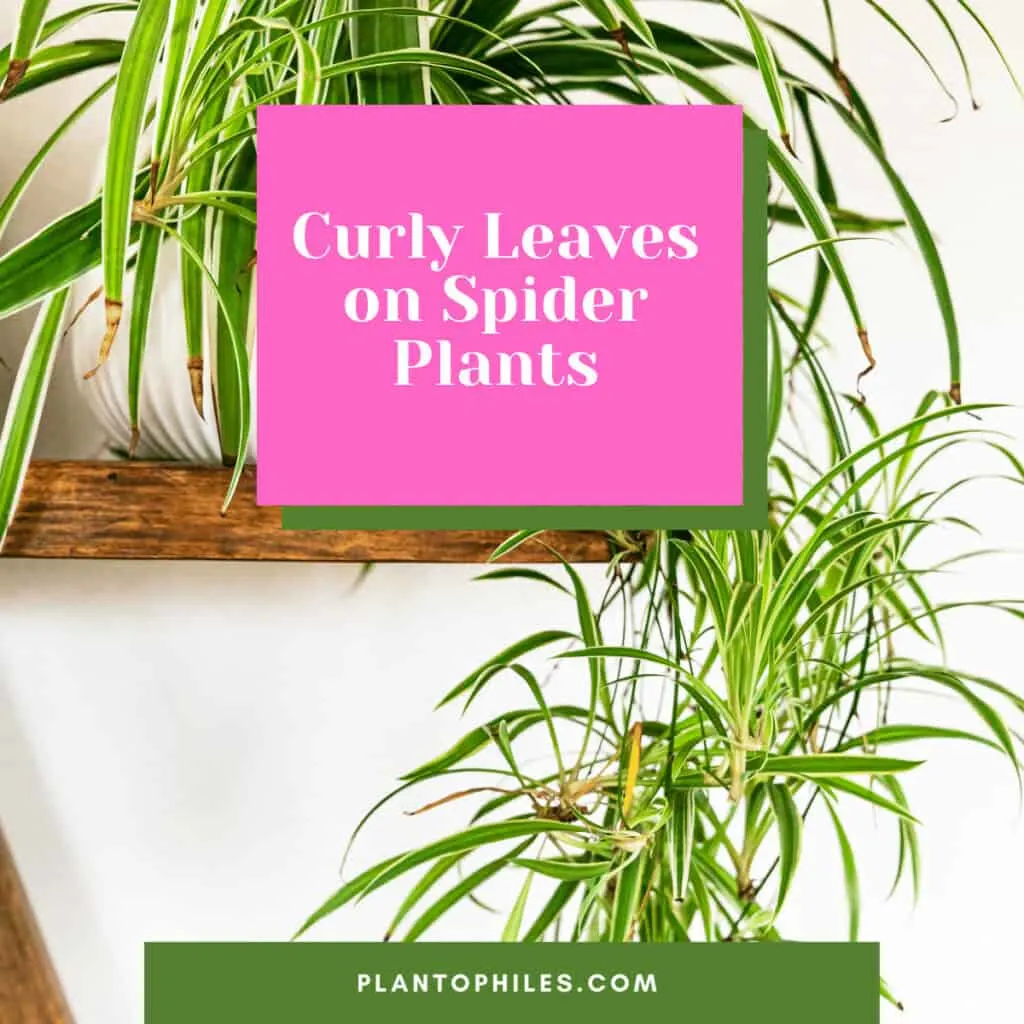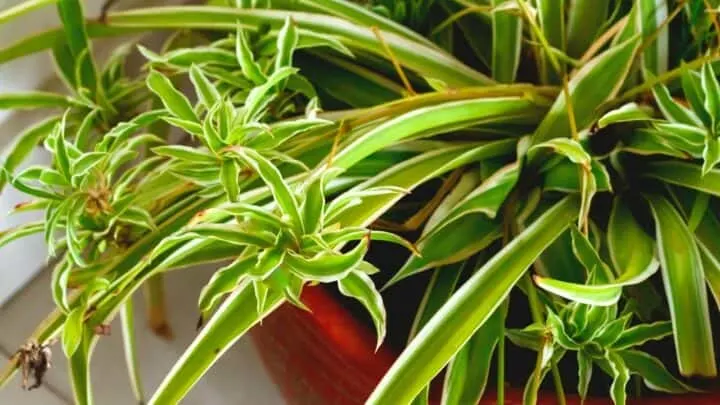Spider plants, or Chlorophytum comosum, tick all the boxes to be great houseplants: easy to care for, likes a household environment, resistant to most pests and diseases, looks great.
As a bonus, they even help clean the air in your home!
There are a few things that can pose problems for your spider plants, causing stress that makes their normally flat leaves curl. If your spider plant is looking off, here are a few possible causes—and their solutions!
Table of Contents
Why does my spider plant have curly leaves?
Leaf curling on spider plants is a stress response to factors like improper water or light levels, or to disease and pest pressures like root rot or insects. While there is one variety of spider plant with naturally curly leaves, in most, this symptom indicates something needs to be addressed for your plant to thrive.

1. Too Little Water
This is probably the most common cause of curling leaves. With too little water, the leaves begin to fold in on themselves, turning curled and crinkly. Water is a big factor in helping the leaves hold their shape, which is why plants generally wilt when they’re low on water. With spider plants, that wilt causes the leaves to curl rather than go limp.
Treatment for Too Little Water
This issue is one of the easiest to correct, and spider plants typically spring back quickly once watered. Spider plants prefer to maintain a consistent, moderate moisture level. This can be achieved with small, frequent waterings, and by using an unglazed pot with good drainage holes.
These pots prevent water from pooling while still holding onto enough to keep your plants happy. The soil should feel damp, not wet, about an inch under the surface.
2. Root Rot
Overwatering your plant can also cause leaf curling. Too much water leads to root rot, in which the plant’s roots drown and begin to decompose. The remaining root system, if there is any, can’t sustain the plant, so you’ll see symptoms of stress as it begins to lack water and nutrients usually drawn up by the roots.
Unfortunately, many novice plant keepers often mistake this wilt for lack of water, which further compounds the problem. The first place to check when you notice your spider plant leaves curling is the soil.
If it’s soggy, has an unpleasant odor, or there are signs of visible mold or fungus, your plant is likely suffering from root rot.
Treatment for Root Rot
Whether this condition is treatable will depend on how advanced it is. Remove your spider plant from its pot, rinse away excess spoil, and assess the roots. Cut away any that are slimy, black, or squishy.
If the remaining root system is very small, you may still be able to save the plant, but you’ll need to cut back the leaves as well so the roots are able to provide enough water and nutrients to go around.
Move the trimmed plant into a pot with fresh soil and good drainage. Water well, and make sure any excess liquid drains away. Keep to a careful watering schedule while your plant recovers, making sure not to let it dry out or sit in soggy soil.
3. Pest Infestation
Aphids
Aphids are soft-bodied insects that range from grey to brown to green and even rusty orange, and often cluster on leaves in huge numbers if the infestation goes unchecked, sucking nutrients and moisture from the leaves.
On spider plants, aphids can be tough to spot because the narrow, grass-like blades make a perfect hiding place, especially as the plant gets stressed and the leaves begin to curl. If your plant has adequate water but is still stressed, check the leaves closely for signs of pests.
Treatment for Aphids
If the infestation is mild, spraying down your plant with pressurized water—such as from a handheld sink sprayer—can knock the bugs from the leaves. Make sure to rinse any fallen insects away, or you’ll be right back where you started.
This treatment may need repeating as eggs hatch and new bugs appear, so be vigilant.
For more intense infestations, you can spray your plant with insecticidal soap, which is highly effective against these soft-bodied bugs.
Spider Mites
Another common houseplant pest, spider mites are very small and difficult to spot, but they can easily be identified by the tiny clusters of webbing they leave behind.
Treatment for Spider Mites
Because they’re small and like to hide, your best bet for getting rid of spider mites is a miticide treatment. Neem oil is a great option, as it’s a natural product that’s effective against mites and other pests as well.
4. Too Much Direct Light
Spider plants are native to tropical areas, where they’re found in semi-shaded areas beneath the rainforest canopy. This means the bright but diffuse light of most homes and offices works great for them, but too much direct light can burn them.
If your plant is situated in direct sunlight, the leaves will curl in on themselves to try to protect themselves from the harsh sunlight. It may also look bleached or burned.
Treatment for Too Much Direct Light
Move your spider plant out of direct light and wait for it to recover. The leaves should begin to flatten quickly once it’s in a better environment. If not, check for other issues. Once it’s recovered, cut away any leaves that were badly damaged by sun exposure (those that are excessively bleached or burned).
A Note on the Growth Habit of Spider Plants
There are lots of different spider plant varieties, but one looks quite different from all the rest. It’s called the curly spider plant or, sometimes, the Bonnie spider plant.
The leaves of the curly spider plant grow in graceful swirls rather than the usual straight lines or gentle arcs of the typical spider plant.
It’s quite an attractive variety, but if it’s not clearly marked as a curly spider plant when you buy it, the unusual growth habit can be quite alarming!
The key difference between the curly growth habit and the curl that develops due to stress is the irregularity of the leaf edges.
If the edges begin to draw together and ripple unevenly, it’s a sign of stress. Smooth, flat leaves, whether straight or curved, indicate a healthy plant.
Frequently asked questions about Spider Plants
Why are my spider plant’s leaves turning brown?
Like curling, brown tips on your plant’s leaves are a sign of stress, usually from too little water. Monitor its moisture levels more closely and make sure it’s not rootbound or getting too much direct sunlight.
Can I cut baby spider plants for propagation if my spider plant isn’t thriving?
If your spider plant is stressed, removing any “spiderettes” that form can help the parent plant recover faster. If the plant is infested with pests or disease, however, it’s best to discard the plantlets rather than try to root them as they’re unlikely to thrive.

Daniel has been a plant enthusiast for over 20 years. He owns hundreds of houseplants and prepares for the chili growing seasons yearly with great anticipation. His favorite plants are plant species in the Araceae family, such as Monstera, Philodendron, and Anthurium. He also loves gardening and is growing hot peppers, tomatoes, and many more vegetables.


